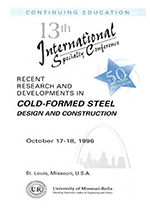Session Dates
17 Oct 1996
Abstract
The basic design requirement for screws in light gauge steel construction is the strength of the screw in a given application (metal-to-metal, wood-to-metal, or metal-to-wood) based on the body diameter of the screw. This statement is clearly obvious from the current AISI screw specifications for lap shear metal-to-metal connections. Recent research has shown that the performance of a screw fastener may also depend on other features of the screw including the head and thread style, and the method of installation (stripped versus unstripped screws). The data presented in this paper address these issues for lap shear connections designed with No. 12 self-tapping screw fasteners. The tests included connections in which the fasteners were properly installed and connections where the fasteners were stripped. The results show that the head style and thread form may have a significant effect on the capacity of the screw fastened lap shear, even where the screws are stripped. For a given type of screw, the results seem to indicate that any beneficial effect of a particular screw design may be diminished in connections where many fasteners are used.
Department(s)
Civil, Architectural and Environmental Engineering
Research Center/Lab(s)
Wei-Wen Yu Center for Cold-Formed Steel Structures
Meeting Name
13th International Specialty Conference on Cold-Formed Steel Structures
Publisher
University of Missouri--Rolla
Document Version
Final Version
Rights
© 1996 University of Missouri--Rolla, All rights reserved.
Document Type
Article - Conference proceedings
File Type
text
Language
English
Recommended Citation
Serrette, Reynaud and Lopez, Victor, "Performance of Self-tapping Screws in Lap-shear Metal-to-metal Connections" (1996). CCFSS Proceedings of International Specialty Conference on Cold-Formed Steel Structures (1971 - 2018). 2.
https://scholarsmine.mst.edu/isccss/13iccfss/13iccfss-session10/2
Performance of Self-tapping Screws in Lap-shear Metal-to-metal Connections
The basic design requirement for screws in light gauge steel construction is the strength of the screw in a given application (metal-to-metal, wood-to-metal, or metal-to-wood) based on the body diameter of the screw. This statement is clearly obvious from the current AISI screw specifications for lap shear metal-to-metal connections. Recent research has shown that the performance of a screw fastener may also depend on other features of the screw including the head and thread style, and the method of installation (stripped versus unstripped screws). The data presented in this paper address these issues for lap shear connections designed with No. 12 self-tapping screw fasteners. The tests included connections in which the fasteners were properly installed and connections where the fasteners were stripped. The results show that the head style and thread form may have a significant effect on the capacity of the screw fastened lap shear, even where the screws are stripped. For a given type of screw, the results seem to indicate that any beneficial effect of a particular screw design may be diminished in connections where many fasteners are used.



